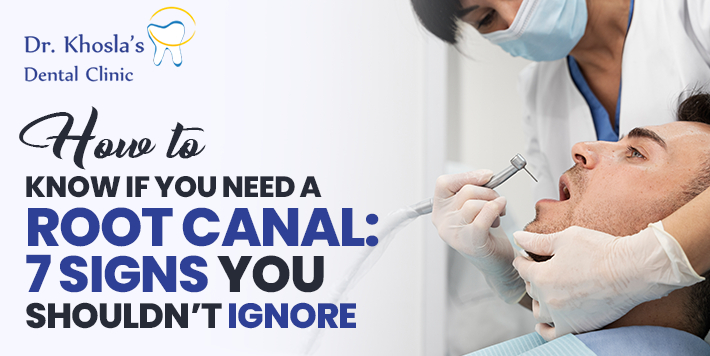When it comes to dental pain, most people hope it will “go away on its own.” But, did you know that 7 out of 10 times, these dental complications, if not treated on time, can lead to much worse issues, sometimes leaving permanent damage?
What starts out as an occasional discomfort can escalate into a severe infection that threatens your natural tooth. In such cases, one of the most common dental treatment routes is to undergo a root canal treatment (RCT).
Contrary to popular belief, root canal isn’t something you need to fear. But, getting it done on time is vital and this guide from Dr. Khosla’s Dental Clinic will point out 7 signs you shouldn’t ignore.
What is a Root Canal and Why is it Done?
Before we familiarise you with the familiar signs, it is vital we understand what a root canal is and why it is done in the first place.
An RCT or root canal treatment is a dental procedure that removes infected or damaged pulp and seals the canal to prevent further reinfection. The dental pulp is a soft tissue comprising nerves, blood vessels, and connective tissue, which explains why you feel severe pain when it’s infected or inflamed.
If you get an RCT done on time, it prevents the risks of having to extract the entire tooth. At Dr. Khosla’s Dental Clinic, our dentists thus emphasise on the importance of “taking the symptoms seriously,” instead of brushing them aside.
7 Warning Signs That You Need a Root Canal Treatment
Often, there are instances where you start experiencing a dull ache in the tooth, which keeps getting worse with time. If the pain resolves in a day or two, chances are that things aren’t as bad.
However, if the pain is recurrent and persistent, that’s a sign that you need to undergo an RCT as soon as possible. Beyond dental pain, following are some of the warning signs to look out for:
1. Persistent Tooth Pain That Doesn’t Go Away
Starting with the most obvious and recurrent symptom, which is tooth pain. Feeling continuous or throbbing pain in the tooth, especially when chewing or applying pressure, is often considered to be the most obvious indicator that something is wrong.
Experiencing occasional sensitivity, as we said, is normal. However, lingering pain signals nerve damage or pulp infection inside the tooth.
What it feels like:
- Pain radiating to the jaw, ear, or face
- Sharp or dull ache that persists for days or weeks
- Pain worsens when lying down or bending over
The reason you shouldn’t ignore it is because persistent dental pain is a telltale sign that the infection has reached the nerve and without treatment, it can infect the surrounding bone.
2. Prolonged Sensitivity to Hot or Cold
Do you feel a sharp pain when you eat something hot or cold? And, does the sensitivity last for a long time, usually more than 30 seconds? If yes, that’s also an indication that the infection has reached the pulp and impacting the nerves.
What it feels like:
- Sharp discomfort that lingers after exposure to temperature
- Sensitivity gradually increasing over weeks
- Discomfort even when not eating or drinking
This is a sign of nerve inflammation inside the dental pulp, which is concerning. If you don’t treat the condition on time, it can cause the nerve to die, leading to further infection and swelling and eventually, tooth loss.
3. Swollen or Tender Gums Near the Tooth
The infection in your dental pulp isn’t always confined to the pulp. Instead, it can infect the surrounding tissues, causing localised swelling in the gums. So, if your gums are tender to touch or you can feel a pimple-like bump (dental abscess), it is a sign of root canal infection, which requires immediate treatment.
What it feels/looks like:
- Swollen, tender gums around a specific tooth
- A boil or pimple on the gum line (fistula)
- Bitter taste in the mouth or bad odor due to pus drainage
The sign of a swollen gum suggests that the infection is further spreading and if you leave it untreated, it will end up infecting the jawbone and cause systemic complications like fever. Undergoing an RCT ensures that the infection is treated at its source.
4. Darkening or Discolouration of the Tooth
When you bruise, the skin becomes discoloured, right? The same is the case with your teeth too. When there’s trauma and infection involved, the internal tissues break down and cause the tooth to appear grey, brown, or black. More than the cosmetic concerns, it is a sign of internal dental damage, which requires immediate medical intervention.
https://govisumber.cfga.gov.mn/
What it looks like:
- A single tooth darker than others
- Discolouration that doesn’t respond to whitening treatments
- Accompanied by pain or sensitivity in many cases
The sign of darkening or discolouration of the tooth is a sign of pulp necrosis. So, the sooner the tooth is treated with RCT, the better are the chances of saving the tooth.
5. Swelling in the Jaw or Face
Severe infection in the dental pulp often contributes to a host of other symptoms, including swelling in the jaw and face. This is a sign that the infection has progressed beyond the tooth and gums and has infiltrated into the jawbone and facial tissues. Besides the swelling, you will also experience difficulty opening the mouth or chewing.
What it feels/looks like:
- Puffy cheek or jaw area near the affected tooth
- Pain radiating to the ear or neck
- Fever or general malaise in advanced cases
The moment you notice your face or jawline swelling, it means that the infection is rapidly spreading and becoming even more severe. Immediate dental care and an RCT is highly recommended by our dentists at Dr. Khosla’s Dental Clinic in such cases to prevent systemic infections and medical emergencies.
6. Pain While Biting or Chewing
If biting down causes sharp pain in a specific tooth, it may indicate cracked tooth syndrome or infection spreading to the ligament around the tooth’s root.
What it feels like:
- Sharp pain on biting or releasing bite
- Sensation of tooth “feeling high” or protruding
- Tenderness when tapping the tooth lightly
When you are experiencing pain while chewing your food, it suggests potential inflammation in the root area or surrounding bone. Undergoing an RCT eliminates the infection and allows for proper restoration to restore the function.
7. Tooth Mobility or Loosening
As previously mentioned, if you don’t treat your dental pulp infection on time, it can weaken the tooth, cause tooth mobility or loosening and eventually tooth loss. When your infection advances, it can weaken the supporting bone around the teeth, accompanied by gum swelling and pus discharge.
What it feels like:
- Tooth feels “wobbly” when touched
- Difficulty chewing on that side
- Combined with other symptoms like pain or discoloration
When you start noticing loose teeth, it is a sign that the infection has compromised the bone. In such cases, you’d need timely RCT followed by restorative dental work to stabilise the tooth and prevent tooth loss.
Also read: Teeth Cleaning in Delhi
Why Ignoring These Signs Can Be Dangerous?
Despite experiencing multiple of these complications and risky signs, if you are still ignoring them, you enhance the risks of serious complications like:
- Dental abscesses (pockets of pus)
- Bone loss around the root
- Spread of infection to the jaw, sinuses, or bloodstream
- Chronic pain and difficulty chewing
Prompt evaluation by an experienced dentist is highly recommended at Dr. Khosla’s Dental Clinic. The earlier you undergo an RCT, the less invasive it is compared to when the infection is advanced.
Don’t Wait Schedule Your Consultation Today!
Root canal treatment is often the last line of defense to save a natural tooth from extraction. The 7 signs discussed including persistent pain, sensitivity, swelling, discoloration, jaw swelling, biting pain, and tooth mobility should never be ignored. Prompt treatment not only alleviates pain but also preserves your natural smile.
Your dental health can’t wait for “someday.” If you suspect you need a root canal or are experiencing unexplained tooth pain, contact Dr. Khosla’s Dental Clinic today for an expert evaluation.
Give us a call or schedule your consultation online

